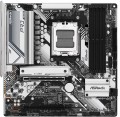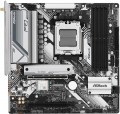Add to comparison |  |  |
|---|---|---|
| ASRock B650M Pro RS | ASRock B650M Pro RS WiFi | |
| Compare prices 12 | Compare prices 1 | |
| TOP sellers | ||
| Features | gaming | gaming |
| Socket | AMD AM5 | AMD AM5 |
| Form factor | micro-ATX | micro-ATX |
| Power phases | 11 | 11 |
| VRM heatsink | ||
| Size (HxW) | 244x244 mm | 244x244 mm |
Chipset | ||
| Chipset | AMD B650 | AMD B650 |
| BIOS | Ami | Ami |
| UEFI BIOS | ||
RAM | ||
| DDR5 | 4 slot(s) | 4 slot(s) |
| Memory module | DIMM | DIMM |
| Operation mode | 2 channel | 2 channel |
| Max. clock frequency | 7200 MHz | 7200 MHz |
| Max. memory | 192 GB | 192 GB |
| XMP | ||
| EXPO support | ||
Drive interface | ||
| SATA 3 (6Gbps) | 4 | 4 |
| M.2 connector | 3 | 3 |
| M.2 | 2xPCI-E 4x, 1xPCI-E 2x | 2xPCI-E 4x, 1xPCI-E 2x |
| M.2 SSD cooling | ||
| Integrated RAID controller | ||
Expansion slots | ||
| PCI-E 16x slots | 2 | 2 |
| PCI Modes | 16x/4x | 16x/4x |
| PCI Express | 4.0 | 4.0 |
| CrossFire (AMD) | ||
| Steel PCI-E connectors | ||
Internal connections | ||
| TPM connector | ||
| USB 2.0 | 2 | 2 |
| USB 3.2 gen1 | 2 | 2 |
| USB C 3.2 gen1 | 1 | 1 |
| ARGB LED strip | 3 | 3 |
| RGB LED strip | 1 | 1 |
Video outputs | ||
| HDMI output | ||
| HDMI version | v.2.1 | v.2.1 |
| DisplayPort | ||
| DisplayPort version | v.1.4 | v.1.4 |
Integrated audio | ||
| Audiochip | Realtek ALC897 | Realtek ALC897 |
| Sound (channels) | 7.1 | 7.1 |
Network interfaces | ||
| Wi-Fi | Wi-Fi 6E (802.11ax) | |
| Bluetooth | Bluetooth v 5.2 | |
| LAN (RJ-45) | 2.5 Gbps | 2.5 Gbps |
| LAN ports | 1 | 1 |
| LAN controller | Dragon RTL8125BG | Dragon RTL8125BG |
External connections | ||
| USB 2.0 | 4 | 4 |
| USB 3.2 gen1 | 2 | 2 |
| USB 3.2 gen2 | 1 | 1 |
| USB C 3.2 gen2 | 1 | 1 |
Power connectors | ||
| Main power socket | 24 pin | 24 pin |
| CPU power | 8 pin | 8 pin |
| Fan power connectors | 5 | 5 |
| CPU Fan 4-pin | 2 | 2 |
| Chassis/Water Pump Fan 4-pin | 3 | 3 |
| Added to E-Catalog | june 2023 | june 2023 |